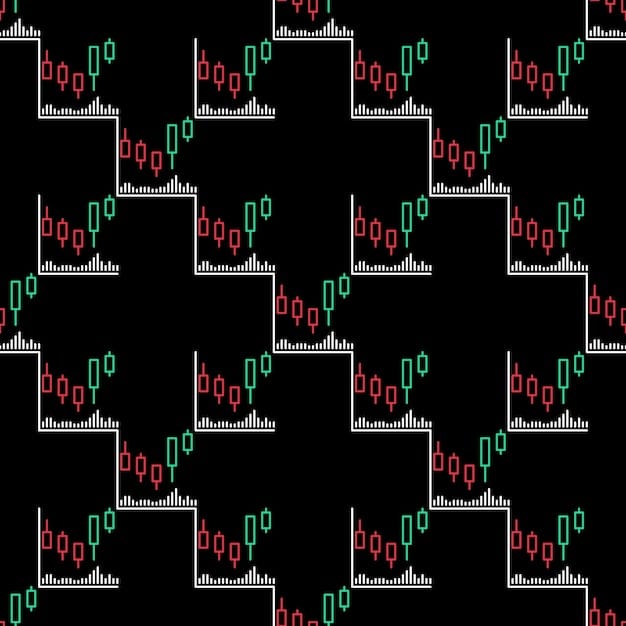Altcoin Technical Analysis: Chart Patterns for Entry and Exit Points

Altcoin technical analysis involves using chart patterns to identify optimal entry and exit points, enabling traders to make informed decisions and maximize potential profits in the volatile cryptocurrency market.
Navigating the world of altcoins can seem daunting, but mastering altcoin technical analysis, especially chart patterns, can give you a significant edge in identifying precise entry and exit points. Learn how to read the market and make smarter trades.
Understanding Altcoin Technical Analysis
Altcoin technical analysis is the practice of evaluating altcoins by analyzing statistical trends gathered from trading activity, such as price movement and volume. It’s a method used to forecast future price movements based on historical data. This contrasts with fundamental analysis, which examines economic and financial factors.
Technical analysis is particularly useful in the fast-paced world of cryptocurrency trading. By understanding different technical indicators and chart patterns, traders can better assess the potential risks and rewards associated with trading specific altcoins.
Key Components of Technical Analysis
Several key components form the foundation of technical analysis. These include:
- Price Action: Analyzing how the price of an altcoin changes over time to identify trends and potential trading opportunities.
- Volume: Monitoring the number of coins traded within a specific period to gauge the strength behind price movements.
- Chart Patterns: Recognizing recurring formations on price charts that suggest potential future price movements.
These components work together to provide a holistic view of an altcoin’s potential performance. By focusing on these areas, traders can make more informed decisions based on data-driven insights.
In conclusion, understanding the basics of altcoin technical analysis, including price action, volume, and chart patterns, sets the stage for making informed trading decisions. The goal is to predict future price movements and identify optimal entry and exit points based on historical data.
Essential Chart Patterns for Altcoin Trading
Chart patterns are visual formations on price charts that can indicate future price movements. Recognizing these patterns is a cornerstone of altcoin technical analysis. These formations are created by repeating market psychology and, when identified correctly, can provide valuable insights into potential trading opportunities.
Different chart patterns can signal either continuation or reversal of trends. Understanding these patterns helps traders make informed decisions about when to enter or exit a trade.

Bullish Chart Patterns
Bullish chart patterns indicate that the price of an altcoin is likely to increase. Some common bullish patterns include:
- Bull Flags: Short-term continuation patterns that form after a sharp price increase, suggesting the uptrend will continue.
- Ascending Triangles: Patterns characterized by a flat upper trendline and a rising lower trendline, indicating increasing buying pressure.
- Double Bottoms: Reversal patterns that form after a decline, suggesting the downtrend is over and a new uptrend is beginning.
Bearish Chart Patterns
Bearish chart patterns suggest that the price of an altcoin is likely to decrease. Some well-known bearish patterns are:
- Bear Flags: Short-term continuation patterns that form after a sharp price decrease, indicating the downtrend will continue.
- Descending Triangles: Patterns characterized by a flat lower trendline and a declining upper trendline, indicating increasing selling pressure.
- Head and Shoulders: Reversal patterns that form after an uptrend, suggesting the uptrend is ending and a new downtrend is beginning.
In summary, chart patterns are an essential tool in altcoin technical analysis, providing crucial insights into potential price movements. Whether bullish or bearish, recognizing and interpreting these patterns can significantly improve trading outcomes.
Identifying Entry Points with Precision
Identifying precise entry points is a crucial skill in altcoin technical analysis. An entry point is the price at which you enter a trade. Selecting the right entry point can significantly impact your potential profit and risk.
Effective entry points are often determined using a combination of chart patterns, technical indicators, and risk management strategies. The goal is to find a balance between entering a trade early enough to capture profits and avoiding premature entry that could lead to losses.
Using Support and Resistance Levels
Support and resistance levels are key areas on a price chart where the price tends to find a barrier. These levels can serve as potential entry points:
- Support Level: A price level where the price tends to bounce, making it a potential entry point for buying.
- Resistance Level: A price level where the price tends to stop rising, making it a potential entry point for selling (shorting).
When the price breaks through a resistance level, it can become a new support level, and vice versa. This understanding is critical for making informed trading decisions.
Combining Chart Patterns and Indicators
For even greater precision, combine chart patterns with technical indicators. For instance:
Using a moving average convergence divergence (MACD) indicator to confirm a bullish flag pattern.
Employing the Relative Strength Index (RSI) to confirm a double bottom pattern.
In conclusion, identifying entry points with precision requires a combination of analyzing chart patterns, understanding support and resistance levels, and using technical indicators. The goal is to find the most favorable price to enter a trade, maximizing potential profit and minimizing risk.
Defining Exit Points for Optimal Profit
Defining exit points is just as important as identifying entry points in altcoin technical analysis. An exit point is the price at which you exit a trade, whether to take profit or cut losses. A well-defined exit strategy can protect your capital and maximize your gains.
Exit points are typically determined based on a combination of technical analysis, risk tolerance, and profit goals. It’s essential to have a clear plan before entering a trade to avoid emotional decision-making.

Setting Stop-Loss Orders
Stop-loss orders are essential for managing risk. These orders automatically exit a trade when the price reaches a predefined level, limiting potential losses. Some strategies include:
Placing a stop-loss order below a support level to protect against a sudden price drop.
Using a trailing stop-loss to lock in profits as the price moves in your favor.
Setting Take-Profit Orders
Take-profit orders are used to lock in gains by automatically exiting a trade when the price reaches a predefined level. This can be based on:
- Identifying resistance levels where the price is likely to encounter selling pressure.
- Setting a profit target based on a risk-reward ratio.
- Using Fibonacci retracement levels to identify potential profit targets.
By defining exit points, traders can manage their risk effectively and ensure they are capturing profits systematically.
In summary, defining exit points for optimal profit requires a clear strategy that involves setting both stop-loss and take-profit orders. This approach protects capital, maximizes gains, and ensures emotional decisions don’t interfere with a well-thought-out trading plan.
Advanced Technical Indicators for Altcoins
Advanced technical indicators can enhance your altcoin technical analysis by providing additional insights into price movements and market trends. These indicators often combine multiple data points to provide a more comprehensive view of potential trading opportunities.
While basic chart patterns and indicators are useful, learning advanced tools can give you a competitive edge by identifying subtle signals that others might miss.
Fibonacci Retracement Levels
Fibonacci retracement levels are horizontal lines on a price chart that indicate potential support and resistance levels. These levels are based on the Fibonacci sequence and can help you identify potential entry and exit points:
Identifying potential pullback areas during an uptrend.
Spotting potential reversal points during a downtrend.
Ichimoku Cloud
The Ichimoku Cloud is a comprehensive technical indicator that provides multiple layers of information, including support and resistance levels, trend direction, and momentum. It consists of five lines:
Conversion Line (Tenkan-sen)
Base Line (Kijun-sen)
Leading Span A (Senkou Span A)
Leading Span B (Senkou Span B)
Lagging Span (Chikou Span)
By mastering these advanced technical indicators, traders can gain a deeper understanding of market dynamics and improve their trading results.
In conclusion, advanced technical indicators like Fibonacci retracement levels and the Ichimoku Cloud can significantly enhance altcoin technical analysis. These tools provide deeper insights into potential support and resistance levels, trend direction, and momentum, improving overall trading strategies.
Risk Management in Altcoin Technical Analysis
Effective risk management is crucial for successful altcoin technical analysis and trading. The cryptocurrency market is highly volatile, and without a solid risk management strategy, traders can quickly lose capital.
Risk management involves identifying, assessing, and mitigating potential risks. This includes setting stop-loss orders, diversifying your portfolio, and managing your position sizes.
Position Sizing Strategies
Position sizing involves determining how much capital to allocate to each trade. Effective position sizing can prevent a single loss from significantly impacting your overall account balance:
- Fixed Percentage: Risking a fixed percentage of your capital on each trade.
- Volatility-Based: Adjusting your position size based on the volatility of the altcoin.
Diversification Techniques
Diversification involves spreading your investments across multiple altcoins and asset classes. This can reduce your overall risk by ensuring that a single altcoin’s poor performance doesn’t significantly impact your portfolio:
- Investing in a mix of large-cap and small-cap altcoins.
- Allocating a portion of your portfolio to stablecoins to reduce volatility.
By implementing robust risk management strategies, you can protect your capital and increase your chances of long-term success in altcoin trading.
In summary, risk management is an integral part of altcoin technical analysis. By using effective position sizing strategies and diversification techniques, traders can minimize potential losses and protect their capital, ensuring long-term viability in the volatile cryptocurrency market.
| Key Point | Brief Description |
|---|---|
| 📈 Chart Patterns | Visual formations that signal potential price movements. |
| 🎯 Entry Points | Prices to enter trades, often based on support and resistance. |
| 🛑 Exit Points | Prices to exit trades, using stop-loss and take-profit orders. |
| 🛡️ Risk Management | Strategies to protect capital, including position sizing and diversification. |
[FAQ Section]
▼
Altcoin technical analysis involves analyzing statistical trends and price movements to forecast future price actions. It relies on historical data, volume, and chart patterns to make informed trading decisions.
▼
Chart patterns are visual formations on price charts that suggest potential future price movements. Recognizing these patterns can help traders identify entry and exit points with greater accuracy.
▼
Common bullish chart patterns include bull flags, ascending triangles, and double bottoms. These patterns indicate that the price of an altcoin is likely to increase, offering potential buying opportunities.
▼
Risk management strategies include setting stop-loss orders, diversifying your portfolio, and carefully determining position sizes. These techniques help protect your capital and minimize potential losses.
▼
Fibonacci retracement levels are horizontal lines on a price chart that indicate potential support and resistance levels. These levels are based on the Fibonacci sequence and help identify entry and exit points.
Conclusion
Mastering altcoin technical analysis, particularly the use of chart patterns and technical indicators, can significantly enhance your trading outcomes. By integrating these techniques with effective risk management strategies, you can navigate the volatile cryptocurrency market with greater confidence and precision, maximizing your potential profits while minimizing risks.





